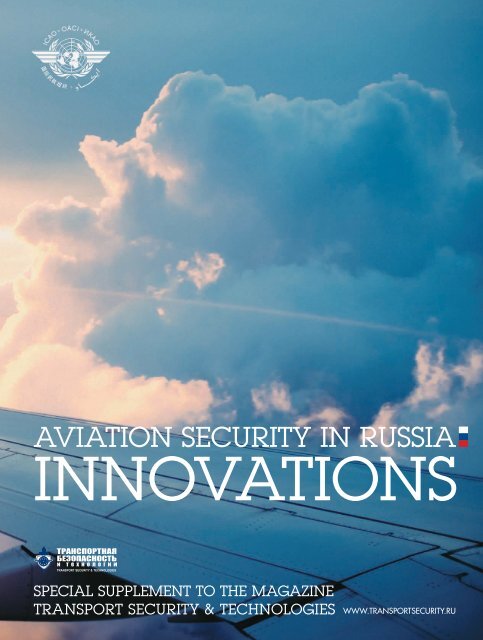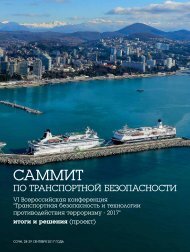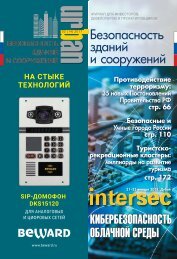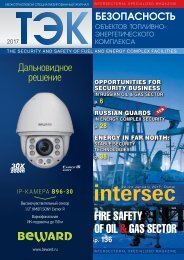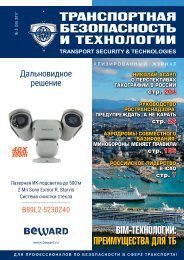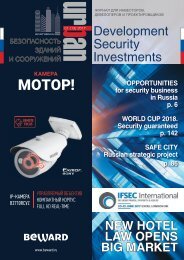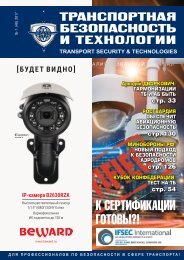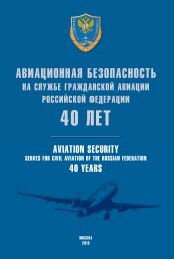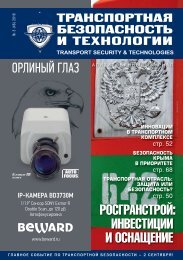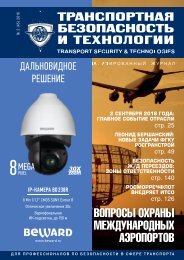Приложение к журналу "Транспортная безопасность и технологии" - 2017
К началу работы Симпозиума ИКАО подготовлено англоязычное приложение к журналу "Транспортная безопасность и технологии", в котором представлены инновационные наработки Российской Федерации в системе обеспечения авиационной безопасности.
К началу работы Симпозиума ИКАО подготовлено англоязычное приложение к журналу "Транспортная безопасность и технологии", в котором представлены инновационные наработки Российской Федерации в системе обеспечения авиационной безопасности.
You also want an ePaper? Increase the reach of your titles
YUMPU automatically turns print PDFs into web optimized ePapers that Google loves.
AVIATION SECURITY IN RUSSIA<br />
INNOVATIONS<br />
SPECIAL SUPPLEMENT TO THE MAGAZINE<br />
TRANSPORT SECURITY & TECHNOLOGIES WWW.TRANSPORTSECURITY.RU
Table оf Content<br />
About ICAO ................................................................................................... 5<br />
The Russian Federation as ICAO member state ...................................................6-7<br />
ICAO’s Annex 17. ICAO standards in Russia ....................................................... 8<br />
ICAO’s Annex 9 ............................................................................................ 9<br />
ICAO critical elements. Innovations .............................................................10-49<br />
● Innovations in aviation security legislation ...............................................12-15<br />
● Innovations in aviation security programmes and regulations ......................16-17<br />
● Competent state authorities in the field of aviation security, their powers .......18-19<br />
● Qualifications and staff training ............................................................20-23<br />
● Provision of Technical Guidance, Tools and Security-critical Information ........24-39<br />
● Certification and Approval Obligations ..................................................40-41<br />
● Quality Control Obligations .................................................................42-47<br />
● Resolution of Security Concerns ............................................................48-49<br />
Statistics. Results ......................................................................................50-51<br />
Integrated information management system<br />
for control and oversight activities for transport security ....................................... 52
Special supplement<br />
to the magazine<br />
Transport Security & Technologies
This supplement to the magazine<br />
is timed to the first Global<br />
Aviation Security Symposium<br />
(12 - 14 September, <strong>2017</strong>, Montreal, Canada).
ICAO structure<br />
4
About ICAO<br />
The International Civil Aviation Organization (ICAO) is a UN specialized agency, establishing<br />
the international laws of civil aviation and coordinating its growth to ensure security and efficiency. ICAO was<br />
established by the Convention on International Civil Aviation (Chicago Convention).<br />
The International Civil Aviation Organization was<br />
based on the provisions of Part II of Chicago Convention<br />
of 1944. It undertakes activities since 1974.<br />
Headquarter is located in Montreal, Canada. USSR joined to<br />
ICAO members on the 14 November 1970.<br />
ICAO main objective is ensuring the safe<br />
and orderly growth of international civil aviation<br />
throughout the world and other aspects<br />
of organizing and coordinating international<br />
cooperation on the all issues of civil aviation,<br />
including international transportations.<br />
One of ICAO functions is to assign to the<br />
world’s airports four-digit individual codes<br />
used for the transmission of aeronautical<br />
and meteorological information on airports,<br />
flight plans, the designation of civil<br />
aerodromes on navigation maps and etc.<br />
ICAO structure<br />
• ASSEMBLY<br />
• COUNCIL<br />
• SECRETARIAT<br />
In accordance with Article 43 of the Convention<br />
on International Civil Aviation, the organization<br />
“is made up of an Assembly,<br />
a Council, and such other bodies as may be<br />
necessary”.<br />
ICAO Leaders<br />
Dr. Olumuyiwa Benard Aliu<br />
President of the Council, ICAO<br />
The Council shall elect its President for a<br />
term of three years. He may be reelected.<br />
5<br />
Dr. Fang Liu<br />
Secretary General, ICAO<br />
ICAO’s Secretary General heads the Secretariat and is the Chief<br />
Executive Officer of the Organization
The Russian Federation as ICAO member state<br />
Recently, the active position of the Federal Authority for Transport Oversight (Rostransnadzor)<br />
has led to a sharp increase of the Russian authority in the international arena<br />
in the field of aviation security. It is in complete accord with the new ICAO’s policy on<br />
inspections of States and strengthening the direction related specifically to improving the<br />
effectiveness of state oversight of aviation security. The most important element of Russia’s<br />
international cooperation with 191 ICAO Member States is the Permanent Mission<br />
of Russia in ICAO.<br />
Its role is enormous and the potential for improving the effectiveness of promoting the<br />
initiatives and interests of Russian civil aviation is almost unlimited.<br />
All the staff of the Russian Mission to ICAO take an active personal part in the continuously<br />
evolving direction – improving aviation security.<br />
MEETINGS OF THIS EXPERT GROUP<br />
ARE HELD ANNUALLY<br />
Expert group on aviation security<br />
Since 2006 to the present time Vladimir Chertok, Deputy Head of the Federal Authority<br />
for Transport Oversight of Ministry of Transport of the Russian Federation, is the coordinator<br />
of cooperation between Russia and ICAO.<br />
An important element of the ICAO’s verification system is the aviation security coordinators<br />
designated by States, ensuring the cooperation of the ICAO Commission with the<br />
inspected State - all its government agencies, organizations and enterprises involved in<br />
aviation security.<br />
In addressing the exiting and evolving threat to civil aviation, ICAO relies on the advice<br />
of experts who sit on the Aviation Security (AVSEC) Panel, established by ICAO in the<br />
late 1980s.<br />
6
Maksim<br />
Sokolov<br />
Minister of Transport<br />
of the Russian<br />
Federation<br />
Valery<br />
Okulov<br />
Deputy Minister<br />
of Transport of the<br />
Russian Federation<br />
Nikolay<br />
Zakhryapin<br />
Deputy Minister<br />
of Transport of the<br />
Russian Federation<br />
The contribution of the Russian Federation to the improvement of ICAO’s activity on aviation security is assessed<br />
high throughout the world.<br />
This is a great merit of the leaders and experts of the Russian Ministry of Transport, Rostransnadzor, Federal Air<br />
Transport Agency, the Russian Mission to ICAO, and personally the Deputy Head of Rostransnadzor Vladimir<br />
Chertok, who is one of the official experts of the ICAO Aviation Security (AVSEC) Panel.<br />
Therefore, not coincidentally, at the<br />
suggestion of the ICAO Regional Bodies<br />
for the European and North-Atlantic<br />
Region, Vladimir Chertok, the Head of<br />
the Russian delegation, the official expert<br />
of AVSEC, was unanimously elected<br />
as Chairman of the EUR/NAT Aviation<br />
Security Group (ENAVSECG) for the next<br />
five years.<br />
Vladimir Chertok<br />
Deputy Head of the Federal Authority for<br />
Transport Oversight in the uniform of the<br />
federal state inspector<br />
The Russian Federation actively supported and participated in the development of the Global Aviation<br />
Security Plan, taking into account the need to achieve 5 key priority outcomes:<br />
improving risk awareness and response;<br />
development of aviation security culture and human performance;<br />
expansion of technical resources and innovations;<br />
improvement of oversight and compliance monitoring of quality;<br />
development of cooperation and support.<br />
7
ICAO’s Annex 17<br />
«Security. Safeguarding International Civil<br />
Aviation Against Acts of Unlawful Interference»<br />
In 1974, the Standards and Recommended<br />
Practices (SARPs) for international civil<br />
aviation were first summarized in Annex<br />
17 to the Chicago Convention, which was<br />
subsequently amended by 15 amendments<br />
ICAO standards in Russia<br />
The proposals of the<br />
Russian Federation<br />
are focused on<br />
the development<br />
of international<br />
cooperation and<br />
concrete measures<br />
to enhance aviation<br />
security at global,<br />
regional and national<br />
levels.<br />
ICAO Standards and Recommended Practices are being implemented in the Russian Federation.<br />
Working papers submitted by Russian specialists are always arousing particular interest among States and international<br />
organizations<br />
8
ICAO’s Annex 9<br />
«Facilitation»<br />
Annex 9 is a document of wide coverage, which reflects ICAO flexibility, keeping pace with the development<br />
of international civil aviation.<br />
In the context of civil aviation, the term<br />
“facilitation” covers a wide range of issues<br />
and activities, and the development of<br />
Standards related to the release of aircraft,<br />
people and goods through formalities at<br />
international border points, on condition of<br />
ensuring an appropriate level of aviation<br />
security.<br />
Annex 9 is aimed at speeding<br />
up procedures related to the arrival<br />
and departure of aircraft, people,<br />
cargo and other items at international<br />
airports. It also contains provisions<br />
related to facilitation of search and<br />
rescue, accident investigations and<br />
evacuation, and relief flights for natural<br />
disasters.<br />
9
ICAO structure<br />
ICAO<br />
CRITICAL ELEMENTS.<br />
INNOVATIONS<br />
10
Innovations in aviation<br />
security legislation
ICAO critical elements. Innovations<br />
1 Innovations in aviation security legislation<br />
FEDERAL LAW OF THE RUSSIAN FEDERATION ON TRANSPORT SECURITY<br />
The Russian Federation defines the basic requirements for transport security, as well as the procedure for categorization,<br />
vulnerability assessment and development of security plans for facilities and vehicles.<br />
The regulative and legal<br />
base has been created and<br />
continues to be developed for<br />
provision of the state transport<br />
security system on the basis<br />
of an integrated approach to<br />
assessment, planning purposes<br />
and realization of security<br />
measures applied to transport<br />
infrastructure and vehicles.
DECREE OF THE PRESIDENT OF THE RUSSIAN<br />
FEDERATION ON IMPLEMENTATION<br />
OF INTEGRATED SYSTEM OF PUBLIC SECURITY<br />
IN TRANSPORT<br />
The Decree has become a real breakthrough in innovation development<br />
of transport security in the Russian Federation. According<br />
to the Decree the Comprehensive Program for Public Security<br />
In Transport has been developed. The Program has inspired the<br />
development and implementation of the state-of-the-art technologies<br />
and equipment much simplifying passenger screening. All<br />
major airports of the Russian Federation has been equipped with<br />
modern technical security systems<br />
In <strong>2017</strong>, the Ministry of Transport of the Russian Federation is<br />
developing a new Comprehensive Program for Security in Transport<br />
until 2020.<br />
The Program’s objective is the protection of life and health in the<br />
transport against unlawful acts, including terrorist nature.
ICAO critical elements. Innovations<br />
1 Innovations in aviation security legislation<br />
Russian President signed the Decree on May 9, <strong>2017</strong> On the<br />
Application of Tightened Security Measures during FIFA Confederations<br />
Cup <strong>2017</strong> and FIFA World Cup 2018.<br />
The security measures are being strengthened in the subjects of<br />
the Russian Federation, within which the infrastructure facilities<br />
are located for hosting the FIFA Confederations Cup <strong>2017</strong> and<br />
the FIFA World Cup 2018, as well as in the adjacent water areas.<br />
The Ministry of Transport of the Russian Federation is ordered to<br />
establish restricted flight zones, forbidden areas for airspace use<br />
over territory and the water area within which enhanced security<br />
measures are being introduced, and to determine when airspace<br />
use of these zones is permitted.<br />
In addition, it is established during the<br />
competition, facilities and other territories<br />
in respect of which special anti-terrorist<br />
protection measures are required, in the<br />
host cities, are subject to enhanced protection,<br />
have to be equipped with engineering<br />
protection and higher protection<br />
class technical security equipment. These<br />
measures are provided by requirements<br />
to anti-terrorist protection of such facilities,<br />
approved by the Government of the<br />
Russian Federation.<br />
Rostransnadzor has inspected and carries<br />
out transport security continuous monitoring<br />
at the transport infrastructure, involved in<br />
the FIFA World Cup 2018.<br />
14
The Reguldation of the RF Government<br />
on Approval of Statute on Federal State Control<br />
(Oversight) in Transport Security Sphere<br />
High-tech directions in oversight methodology have been<br />
approved, and implemented, including:<br />
audits with the use of test-objects and test-items;<br />
information systems to form an audit plan<br />
on the basis of risk assessment;<br />
continues monitoring approach for transport security<br />
requirements compliance;<br />
remote control at the transport infrastructure facilities and vechiles.<br />
15
ICAO critical elements.<br />
Innovations
2 Innovation in aviation security<br />
programmes and regulations<br />
The Regulation of the RF Government On the Approval of Requirements for Transport Security Ensuring<br />
(Including Requirements for the Anti-terrorist Protection of Facilities (Territories), Taking Into Account Requirements<br />
for Facilities of Different Categories of the Transport Infrastructure and Aircrafts<br />
ORDER OF THE MINISTRY OF TRANSPORT OF THE RUSSIAN FEDERATION<br />
On the Approval of the Requirements for Transport Security Ensuring, Taking into Account Requirements for<br />
Facilities of Different Categories of the Transport Infrastructure and Aircrafts.<br />
ORDER OF THE MINISTRY OF TRANSPORT OF THE RUSSIAN FEDERATION<br />
On the Procedure to Inform by Subjects of the Transport Infrastructure and Air Carriers on Threats of Committing<br />
and Committed Unlawful Interference Acts at Transport Infrastructure and Vehicles<br />
ORDER OF THE MINISTRY OF TRANSPORT OF THE RUSSIAN FEDERATION<br />
On the Procedure to Form and Maintain Automated Centralized Bases of Personal Passengers Data and Provision<br />
of Appropriate Information Containing in It.<br />
JOINT ORDER OF THE MINISTRY<br />
OF TRANSPORT OF THE RUSSIAN<br />
FEDERATION, THE FEDERAL SECU-<br />
RITY SERVICE OF THE RUSSIAN<br />
FEDERATION AND THE MINISTRY<br />
OF INTERNAL AFFAIRS OF THE<br />
RUSSIAN FEDERATION<br />
On the Approval of the List of Potential<br />
Threats of Unlawful Interference Acts<br />
Committing in the Operation of Transport<br />
Infrastructure and Vehicles<br />
17
ICAO critical elements.<br />
Innovations
3 Competent state authorities<br />
in the field of aviation security, their powers<br />
THE MINISTRY OF TRANSPORT OF THE RUSSIAN FEDERATION<br />
is an executive federal authority in the field of transport, which formulates the State policy and legal and regulatory<br />
environment in a transport sector, including civil aviation.<br />
FEDERAL AIR TRANSPORT AGENCY<br />
is an executive federal authority, which<br />
renders state services in the field of air<br />
transport (civil aviation), in the field of<br />
using of the Russian Federation airspace,<br />
air navigation service of users of the<br />
Russian Federation airspace and using<br />
state-owned assets in civil aviation.<br />
THE FEDERAL AUTHORITY<br />
FOR TRANSPORT OVERSIGHT<br />
is an executive federal authority, which<br />
oversees (controls) observance of the Russian<br />
Federation legislation and international agreements<br />
of the Russian Federation in a transport<br />
sector, including civil aviation, as specially<br />
authorized body in the field of civil aviation.<br />
19
ICAO critical elements.<br />
Innovations
4 Qualifications and staff training<br />
ORDER OF THE MINISTRY OF<br />
TRANSPORT OF THE RUSSIAN<br />
FEDERATION<br />
On the Approval of the Procedure for the<br />
Transport Security Forces Training<br />
A standard additional professional program in the field of training<br />
employees designated as persons responsible for transport security<br />
ensuring in the transport infrastructure entity at the transportation facility<br />
and/or vehicles, other officers, acting as a Leader in the sphere of<br />
the management of the transport security forces at the transportation<br />
facility and/or aircrafts<br />
21<br />
TRAINING<br />
OF AVIATION<br />
SECURITY<br />
SPECIALISTS<br />
OF DIFFERENT<br />
COUNTRIES<br />
AT MOSCOW<br />
ICAO REGIONAL<br />
AVIATION<br />
SECURITY<br />
TRAINING<br />
CENTER
ICAO critical elements. Innovations<br />
4 Qualifications and staff training<br />
HIGHER EDUCATIONAL INSTITUTIONS OF PROFESSIONAL<br />
EDUCATION<br />
Moscow State Technical University of Civil Aviation<br />
Saint Petersburg State University of Civil Aviation<br />
Ulyanovsk Air Force Academy of Civil Aviation<br />
EDUCATIONAL INSTITUTIONS OF ADDITIONAL PROFESSIONAL<br />
EDUCATION<br />
Aviation training centers for civil aviation located<br />
in the Federal Districts and the regions of the Russian Federation<br />
TRAINING OF SPECIALISTS<br />
FROM DIFFERENT<br />
COUNTRIES IN THE FIELD<br />
OF AVIATION SECURITY IN<br />
THE MOSCOW TRAINING<br />
CENTER OF ICAO<br />
22
Annually, aviation<br />
training centers in<br />
Russia are receiving<br />
for training and<br />
retraining up to<br />
16,000 employees<br />
of airports and<br />
airlines from Russia<br />
and other countries<br />
23
ICAO<br />
CRITICAL ELEMENTS.<br />
INNOVATIONS
Provision of Technical<br />
Guidance, Tools and<br />
Security-critical Information
BRANCH SPECIALIZED<br />
MAGAZINE<br />
FOR TRANSPORT<br />
SECURITY<br />
PROFESSIONALS<br />
TRANSPORT<br />
SECURITY<br />
&TECHNOLOGIES<br />
It is the only magazine on transport and aviation security<br />
in the territory of the Russian Federation and the CIS.<br />
The edition is issued since 2003 with an annual circulation<br />
of 20 000 copies.<br />
The magazine is included in the list of specialized branch<br />
mass media of the Ministry of Transport of the Russian Federation.<br />
The Editor-in-Chief is Sergey Gruzd.<br />
The structure and subject of the magazine cover the features<br />
of integrated security and anti-terrorist protection of<br />
all modes of transport, including air transport, as well as<br />
the issues of ensuring the civil aviation safe development,<br />
both in Russia and throughout the world.<br />
Information and<br />
methodological<br />
assistance to<br />
the magazine is<br />
provided by:<br />
Ministry of Transport of the Russian Federation, Federal Authority<br />
for Transport Overisght, Federal Agency on Air Transport,<br />
the Ministry of Internal Affairs of the Russian Federation,<br />
the Federal Security Service of Russia, EMERCOM of Russia<br />
and other state bodies.<br />
Readers of the magazine are leaders, top managers,<br />
professionals, experts of state bodies, transport enterprises<br />
and organizations in the field of security and antiterrorist<br />
protection, as well as law enforcement and special services<br />
officers, representatives of international associations and<br />
unions, including ICAO, IATA and etc.<br />
Special editions of the magazine are issued regularly,<br />
including with the ICAO materials, for events held by state<br />
bodies, both in Russia (colleges, extended interdepartmental<br />
meetings, etc.) and abroad.<br />
In Russia the magazine is the reference book of the top<br />
managers of the transport (aviation) security services.
Russian Transport Minister Maxim Sokolov and<br />
Deputy Transport Minister of Russia Nikolay<br />
Asaul learn the publications in magazine<br />
Transport Security & Technologies during the<br />
meeting of the Federal Authority for Transport<br />
Oversight board.<br />
It actively assists promotion and dissemination the ICAO policy on state inspections<br />
and strengthens the effectiveness of state oversight on aviation security, the<br />
implementation of the ICAO standards and recommended practices in the Russian<br />
Federation.<br />
Annually in Montreal (Canada) the ICAO members receive special issue or<br />
supplement of the magazine.<br />
The magazine is entrusted with exclusive coverage of its activities in the field<br />
of transport (aviation) security by the largest holdings, carrier companies, airports,<br />
institutions and organizations.<br />
The magazine has assumed the image<br />
of a responsible and reliable operator<br />
of B2B congress and exhibition events<br />
on transport (aviation) security, the largest<br />
on is All-Russian Annual Conference<br />
Transport Security and Counterterrorism<br />
Technologies.<br />
We aspire to keep and enhance the<br />
reputation of a reliable business partner.<br />
Our goal is to be the best!<br />
Contacts<br />
73, Udaltsova St., Moscow, Russian<br />
Federation, 119454<br />
Phone: + 7 (495) 797-35-96;<br />
Phone/Fax: +7 (499) 431-20-65<br />
E-mail: info@transportsecurity.ru<br />
www. transportsecurity.ru.
RPE Automatica-S, LLC<br />
123298, Moscow, 13, build. 1, 3-rd<br />
Khoroshevskaya st.<br />
Tel./Fax: (495) 956-49-95<br />
E-mail: info@avts.ru<br />
www.avts.ru<br />
Perimeter security of the airport is<br />
an important milestone in the protection<br />
of the airport complex<br />
The continuing growth of the world economy<br />
leads to an inevitable increase in the<br />
volume of air transportation, which makes<br />
airport complexes an important part of<br />
the transport infrastructure of any country.<br />
However, at the same time, the risk of acts<br />
of unlawful interference increases both for<br />
passengers and for the airport complexes<br />
themselves. To date, many companies have<br />
achieved remarkable success in developing<br />
a modern traveler’s identification and<br />
luggage screening systems, which forces<br />
terrorists to look for other weaknesses,<br />
one of which may be the perimeter of the<br />
airport complex. At the same time, despite<br />
the development of technologies, it is not<br />
yet possible to solve the tasks of protecting<br />
the lengthy perimeter of airport complexes<br />
qualitatively. The main features of perimeter<br />
security for airport complexes are the<br />
great length of the protected perimeter, a<br />
multitude of interference factors caused by<br />
the take-off and landing of aircraft, and the<br />
influence of weather and climate conditions<br />
- all this leads to a lot of false alarms.<br />
The Research and Design Enterprise<br />
“Avtomatika-C” has extensive experience<br />
in the implementation of sophisticated<br />
automated systems at complex facilities and<br />
for more than 5 years has been successfully<br />
engaged in the creation and implementation<br />
of a unique integrated security system<br />
SOKOL. The integrated security system<br />
SOKOL is an intricacy of interconnected<br />
subsystems that solve the single task of<br />
organizing the protection of any facility object.<br />
SOKOL is based on the perimeter security<br />
subsystem, which is based on the use<br />
of a fiber optic cable (FOC) as a sensitive<br />
element for determining occurrences of a<br />
violation. The integrated approach and use<br />
of an optical cable gives a lot of advantages<br />
in relation to traditional systems:<br />
№ Characteristic Traditional systems Integrated security system SOKOL<br />
1 The influence of various external The reaction is rarely adjusted<br />
The response to the noise level is adjusted<br />
interference:<br />
2 The plane takeoff and landing; Usually strong influence Does not affect;<br />
3 Bad weather (rain, wind, etc.); Average and strong influence Weak influence;<br />
4 Electromagnetic radiation; Average and strong influence Full immunity;<br />
5 The level of false alarms Usually high; Low;<br />
6 The complexity of creating logic for generating Sets any logic for generating alarms;<br />
alarms;<br />
7 The ability to integrate with other<br />
systems<br />
Usually absent<br />
The system can be integrated with virtually any<br />
existing systems;<br />
8 Power and communication at the Transmission of power via one cable and No power at the perimeter;<br />
9 perimeter<br />
communication via another cable<br />
Communication and information could be<br />
organized with dark (unused) fibers;<br />
10 Division into zones and equipment for<br />
the zone<br />
Usually divided into zones with a length of 50<br />
to 1000 m;<br />
The division into zones is virtual and<br />
configurable;<br />
11 It is necessary to place different equipment on<br />
the perimeter for each zone;<br />
On the perimeter there are only fiber optical<br />
closures in the places where the cable is<br />
connected;<br />
12 Requirements for the placement of<br />
stationary equipment<br />
It usually requires accommodation in a<br />
specially prepared room;<br />
Possible location of equipment in an<br />
unprepared room;<br />
13 Features of the service It is necessary to maintain the linear part on The linear part does not require maintenance;<br />
the perimeter and the station part in the room;<br />
14 Assembling features Often, complex installation of the system on Simple installation;<br />
the perimeter;<br />
15 Cost of ownership Low and average cost of acquisition, medium<br />
and high maintenance costs;<br />
16 Accuracy From 50 to 500 m; Up to 10 m. (adjustable);<br />
17 Determining the type of intruder Often impossible;<br />
and indicating the direction of its<br />
movement<br />
Average purchase price, very low<br />
maintenance costs;<br />
Determining the type of intruder: person,<br />
group of person, vehicle and heavy vehicle.<br />
Determining the direction of intruder’s<br />
movement;<br />
18 Determining of the digging A separate system is required It is determined by the cable in the ground;<br />
19 Location in the ground and fence Different systems; In one system;<br />
20 System operability at breakage / cut<br />
of the sensing element<br />
Impossible; Determine the location of the first breakage /<br />
cut with an accuracy of 10 m;
NON-STATE EDUCATIONAL INSTITUTION OF<br />
ADDITIONAL PROFESSIONAL EDUCATION<br />
SCIENTIFIC-TRAINING CENTER “AVIATION<br />
SECURITY AND INNOVATIVE TECHNOLOGIES”<br />
ABINTECH<br />
NEI APE STC ABINTECH<br />
Office 1016, 80 G, Leningradsky<br />
prospect, Moscow, 125190<br />
Tel/Fax: +7 (495) 225-24-45<br />
E-mail: abintech2011@mail.ru<br />
Web site: www.abintech.ru<br />
Aviation and transport security educational<br />
center “ABINTECH” have<br />
25 years of experience training X-ray<br />
screeners and other security staff<br />
for airports and railway stations of<br />
the Russian Federation and some<br />
other countries. “ABINTECH” is<br />
private company, the owner and director<br />
is Mr. Victor Volynskiy.<br />
In the Russian Federation, we<br />
stood at the origins of mass education<br />
of inspection emloyees on a<br />
short-term 40-hour refresher courses<br />
aimed at staff members receive<br />
practical knowledge and skills for<br />
detection of concealed weapons, explosive<br />
devices and other dangerous<br />
items and substances.<br />
We have always tried to use innovative<br />
teaching methods, constantly<br />
conducted research work,<br />
development of course books and<br />
manuals. In 2014 our private training<br />
server for distance learning<br />
was established. Our teachers are<br />
experienced, among them combatants<br />
with combat veterans of special<br />
forces, people who spent many<br />
years in the airlines and in public<br />
administration.<br />
All this led to remarkable success<br />
and popularity of our training center.<br />
Over 100 000 students graduated<br />
short-term practical courses on recognition<br />
of hidden arms and explosive<br />
devices for 26 years.<br />
“ABINTECH” training center is<br />
located at the address: 80 G, Leningradsky<br />
prospect, Moscow, Russia,<br />
in the office building. The total area<br />
of the occupied premises is 200 sq.<br />
m. For full-time study, there are three<br />
classrooms:<br />
The first class is for theoretical<br />
and practical training for 24 people.<br />
The classroom is equipped with<br />
more than 500 samples of weapons<br />
and firearms, ammunition staffing,<br />
models of improvised explosive<br />
devices.<br />
Second class has 12 computers<br />
for work and testing on the X-ray<br />
simulator “Student”, developed by<br />
“ABINTECH”. Also, we have there<br />
the training stand for demonstration<br />
of operation access control systems,<br />
perimeter protection and CCTV.<br />
Third class is for technical training<br />
in which are installed X-ray machine,<br />
walk-through and handheld<br />
metal detectors, trace detectors and<br />
some other equipment.
As for the staff, the company employs<br />
22 people on a regular basis,<br />
13 of which are engaged in teaching<br />
activity.<br />
3. OTHER SECURITY PROGRAMS<br />
• Radiation safety when working<br />
with ionizing radiation sources<br />
(group A personnel) (72 hours);<br />
• combination of full-time and remote<br />
training.<br />
We also conduct field training on<br />
the premises of the customer. Our<br />
Currently our training center conducts<br />
training of security specialists<br />
in the following areas:R<br />
1. TRANSPORT SECURITY<br />
For the transport security, we train<br />
security specialists according to the<br />
model programs provided by the<br />
Russian legislation:<br />
• for the air transport – on all eight<br />
programs;<br />
• for railroad transport – on five<br />
programs.<br />
2. AVIATION SECURITY<br />
In the field of aviation security, we<br />
train specialists in the following<br />
programs:<br />
• Aviation security managers<br />
(40 hours);<br />
• Aviation security instructors<br />
(40 hours);<br />
• The prevention of unauthorized<br />
access to the controlled area of<br />
the airport (40/80 hours);<br />
• Apron control, aircraft security<br />
check (40/80 hours);<br />
• Pre-flight security check of staff<br />
and passengers (40/80 hours);<br />
• Technical maintenance of X-ray<br />
machines and other security<br />
equipment (40 hours);<br />
• Profiling (40 hours).<br />
• Identification and localization of<br />
dangerous objects and substances<br />
(80 hours);<br />
• Screening of visitors, staff and<br />
vehicles (40 hours);<br />
• Screening of visitors and staff in<br />
venues of mass sports activities<br />
(40 hours).<br />
In our training center, there are<br />
three forms of training:<br />
• full-time training;<br />
• remote training (off-line mode),<br />
when student work via Internet on our<br />
server of the distance learning system,<br />
studying the course materials, pass the<br />
intermediate tests and the final examination.<br />
This form of learning is only<br />
possible on certain courses.<br />
teacher comes with a computer and<br />
multimedia projector for displaying<br />
slides, videos and work on the<br />
computer simulator. Practical lessons,<br />
in this case, are done on X-ray<br />
machines and other technical means<br />
of inspection of the customer. This<br />
form of training is very popular.<br />
Our customers include: airports,<br />
railway stations, Gazprom, LUKOIL,<br />
Sberbank, hotels and stadiums.<br />
Regarding the need to protect information,<br />
we don’t work with individuals,<br />
training is conducted only at<br />
the request of organizations.<br />
Read more our activities<br />
can be found on our website<br />
www.abintech.ru
Olfactory Biotechnical System<br />
One of the methods of strengthening existing<br />
security systems is use by transport (aviation)<br />
security units of dogs specially trained in<br />
the detection of explosives – EDD (explosive<br />
detection dogs). But even in this case, wide application<br />
of dogs is interfered by a number of<br />
objective circumstances, which decrease efficiency<br />
of their search activity:<br />
a) correlation between efficiency of dogs’<br />
activity and environment conditions;<br />
b) restrictions on duration of active work<br />
of each dog;<br />
c) lack of objective (instrumental) control<br />
of work results.<br />
PJSC “Aeroflot – Russian airlines” has developed<br />
approach and created technology that<br />
makes it possible to solve all well-known problems<br />
that limit the efficiency of EDD use for the<br />
purposes of transport (aviation) security.<br />
This approach provides an opportunity<br />
to carry out systematic, regular and targeted<br />
olfactory investigation at transport infrastructure<br />
objects and transport vehicles, to<br />
reduce the time of reaction and to increase<br />
accuracy of activity – the main factors, that<br />
characterize the efficiency of aviation security<br />
measures.<br />
The optimal solution of a problem is the<br />
combination of unique olfactory qualities<br />
of EDD and modern technical equipment<br />
which is carried out by means of technological<br />
integration into Olfactory Biotechnical System<br />
(further in the text OBTS).<br />
This paper provides description of the main<br />
technical characteristics of OBTS that allows<br />
implementation and application of olfactory<br />
monitoring in system of transport (aviation)<br />
security. Olfactory monitoring is considered as<br />
the instrument providing preventive measures<br />
in detection of prohibited (limited) objects by<br />
their specific odor by means of EDD.<br />
Structure and principle of OBTS functioning<br />
This solution represents set of the biological<br />
and technical elements united in functional<br />
system of targeted application intended for detection<br />
of explosives and explosive devices. The<br />
proposed solutions allow to combine optimum<br />
merits of olfactory opportunities of EDD with<br />
advantages of technical systems at mutual compensation<br />
of their shortcomings.<br />
The final result of OBTS application is<br />
obtaining of objective, documentary issued<br />
report on presence or lack of explosives on the<br />
surveyed object.<br />
The system provides transfer of the<br />
received results of search activity to the<br />
control center in real time. Thus the principle:<br />
technique – animal (bio - system) – human is<br />
implemented.<br />
OBTS CONSISTS OF<br />
THE FOLLOWING ELEMENTS:<br />
1 Biodetectors – jackal – dog hybrid – Sulimov’s<br />
dog<br />
The main distinctive properties of hybrid<br />
dogs comparing to traditional breeds of guard<br />
dogs are:<br />
• expanded temperature range of application<br />
in various physical-climatic conditions<br />
(experiments were carried out in Russia at<br />
temperatures under – 30 °C and in the United<br />
Arab Emirates at temperatures under + 42 °C);<br />
• increased level of sensitivity and selectivity<br />
of olfactory system on main types of<br />
explosives and other target substances;<br />
• high level of natural orientation and<br />
interest in search activity;<br />
• small size and weight of animals – it is<br />
possible to apply them in limited spaces of<br />
cabin, luggage and technical compartments of<br />
aircraft.
2 Technology of Remote Analysis of the Air<br />
Environment (RAAE)<br />
The Remote Analysis of the Air Environment<br />
(RAAE) is optional olfactory research<br />
with specially trained dogs acting as a sensor,<br />
and filters with air pumped through them from<br />
target object subjected to inspection as a subject.<br />
system in general, and its’ elements separately.<br />
The novelty of the elements listed above is confirmed<br />
by a number of patents for inventions,<br />
now they exist in the form of prototypes, they<br />
function in the regime of trial operation and<br />
their future owners would organize their mass<br />
production.<br />
RAAE is one of elements of aviation security<br />
management system, it provides carrying<br />
of olfactory monitoring of all processes in the<br />
airport. The idea of RAAE method consists<br />
in periodic sampling of air from the surveyed<br />
objects (rooms, cargo compartments, containers<br />
and cargo load units) with sedimentation<br />
on filters of dustlike inclusions or molecules of<br />
the target substances dissolved in air.<br />
Depending on particular requirements it is<br />
possible to develop both olfactory biotechnical<br />
3. Hardware - software complex of registration<br />
and integral analysis of physiological<br />
parameters of EDD.<br />
PJSC “Aeroflot – Russian airlines” jointly<br />
with Government Research Center FMBC<br />
A. I. Burnazyan FMBA of Russia developed a<br />
method of objectification of target substances<br />
search results with use of EDD.<br />
The hardware and software system of<br />
registration and the integral analysis of physiological<br />
parameters of EDD (“Layka”) realizes<br />
the integrated approach which is based on the<br />
analysis of dynamics of bioelectric activity of<br />
the brain and an assessment of the correlating<br />
influence of the central nervous system on<br />
activities of other systems of an organism.<br />
“Layka” consists of two main parts: mobile<br />
module and remote module.<br />
The mobile module represents an equipment<br />
complex: a set of electrophysiological<br />
electrodes for registration of the electroencephalogram<br />
(EEG), the electrocardiogram<br />
(ECG), the actogram (AG), the amplifier<br />
transmitter of signals, the unit of software<br />
hands-off processing of electrophysiological<br />
parameters of EDD.<br />
The mobile module placed on a body of<br />
EDD allows to control bioelectric potentials<br />
of a brain with an assessment of frequency<br />
and power of the dominating rhythm of EEG,<br />
correlative relations between the dominating<br />
rhythm of EEG and the frequency of breathing<br />
and a warm rhythm, the ECGs parameters,<br />
breathings and others during search activity.<br />
The remote module, represents a portable<br />
personal computer (notebook) having necessary<br />
operating characteristics and equipped<br />
with a special program for the reception,<br />
analysis and an archiving of the biometric<br />
parameters registered for EDD.<br />
The results of information analysis are<br />
reflected in automatically created protocol of<br />
research in which the reaction of the central<br />
nervous system of an animal and the appropriate<br />
vegetative parameters of dogs in the course<br />
of search is documented and in case of the<br />
detection of target substance by them.<br />
Implementation of biotechnical system of<br />
“Olfactory monitoring” allows:<br />
e) to carry out systematic and regular cynological<br />
inspection of controlled objects, to provide<br />
their security from explosions of a criminal<br />
or terrorist orientation;<br />
f ) to carry out olfactory investigation in<br />
crowded places during mass actions;<br />
g) to control transport vehicles and transported<br />
freights in order to exclude the delivery<br />
of explosives;<br />
h) to increase efficiency of instructor - dog<br />
search activity;<br />
i) to provide objectification of dogs’ search<br />
activity and its’ documentation.
ICAO critical elements.<br />
Innovations
6 Certification and Approval Obligations<br />
The RF Governmental Regulation dated on 26 September,<br />
2016 No. 969 On Approval of Requirements for the<br />
Functional Properties of Technical Means for Transport Security<br />
Ensuring and the Rules for Compulsory Certification of Technical<br />
Means for Transport Security Ensuring<br />
On September 26, 2016, the RF Government<br />
approved the requirements for the<br />
functional properties of technical means for<br />
transport security ensuring and enacted the<br />
Regulations for Compulsory Certification<br />
of Technical Means for Transport Security<br />
Ensuring (The RF Governmental Regulation<br />
No. 969).<br />
In accordance with paragraph 8 of the Article 12.2 of the Federal Law No. 16 dated on 09.02.2007<br />
On Transport Security “Technical means of transport security (systems and means of alarms, access<br />
control, inspection, video surveillance, audio and video recordings, communication, alert, collection,<br />
processing, reception and transmission of information intended to use at transport infrastructure facilities<br />
and vehicles in order to ensure transport security) are subject to compulsory certification”.<br />
41
ICAO critical elements.<br />
Innovations
7 Quality Control Obligations<br />
In March <strong>2017</strong>, the list of state control types, when a risk-oriented approach is applied,<br />
has been supplemented by 33 types of state control (oversight).<br />
The list also includes federal state control (oversight) in the sphere of transport security.<br />
The RF Governmental regulation dated on March 2, <strong>2017</strong> No. 245<br />
On Amendments to the RF Governmental Regulation Dated on August 17, 2016 No. 806.<br />
The RF Governmental Regulation<br />
dated on October 4, 2013<br />
No. 880<br />
On the Approval of the Provision on<br />
Federal State Control (Oversight) in the<br />
Sphere of Transport Security.<br />
43
ICAO critical elements. Innovations<br />
7 Quality Control Obligations<br />
Administrative Violations Code of the Russian Federation<br />
(dated on 30.12.2001 No. 195-FZ (with amendments<br />
dated on 03.02.2014).<br />
More rigid sanctions for security violations have been implemented<br />
Authority of the state security oversight bodies has been extended<br />
Implementation of the continuous<br />
monitoring mechanism under the<br />
ICAO Universal Security Audit<br />
Programme the implementation<br />
of this mechanism should increase:<br />
the transparency of the aviation<br />
security state, the response and the measures<br />
adoption speed; the intensified process<br />
of equipping and additional equipping<br />
the facilities with engineering and<br />
technical means of protection, aviation<br />
and transport security.<br />
The objective of the transition to the<br />
continuous monitoring mechanism is to increase<br />
the level of compliance with ICAO<br />
standards and the oversight functions of<br />
the state, which is the basis for the safe<br />
operation of civil aviation.<br />
Federal law dated on<br />
26.12.2008 No. 294-fz on protection<br />
of legal entities and<br />
individual entrepreneurs rights<br />
during implementation of state<br />
control (oversight) and municipal<br />
control<br />
Planned (raid) inspections of vehicles are<br />
carried out by authorized officials of the<br />
state control (oversight) authorities on the<br />
basis of planned (raiding) tasks.<br />
It is possible to use checklists (lists of control<br />
questions) during state control (oversight)<br />
or scheduled inspection. *<br />
*-------------------------------<br />
The implementation of checklists is stipulated<br />
by the plan of measures to improve<br />
control and oversight activities for 2016-<br />
<strong>2017</strong>, approved by the RF Government in<br />
2016 and the priority program Reform of<br />
Control and Oversight Activities.<br />
The Order of the Federal Authority for Transport Oversight<br />
Dated on January 30, 2014 No. AK-100fs<br />
On the commissioning of an Integrated Information Management System<br />
for Control and Oversight Activities to Ensure Transport Security<br />
44
The main automated transport control and oversight center of the Federal Authority for<br />
Transport Oversight and automated transport control and oversight network in the federal districts of Russia.<br />
The Main Automated Transport Control and Oversight Center provide<br />
continuous monitoring of transport security;<br />
control for taking immediate measures in case of a contingency<br />
THE MAIN AUTOMATED<br />
TRANSPORT CONTROL AND<br />
OVERSIGHT CENTER OF THE<br />
FEDERAL AUTHORITY FOR<br />
TRANSPORT OVERSIGHT IS<br />
AN ICAO AVIATION SECURITY<br />
POINT-OF-CONTACT IN THE<br />
RUSSIAN FEDERATION<br />
ISO 28000: 2007standard is<br />
an international standard, developed<br />
by the International Organization for<br />
Standardization (ISO) in response to the<br />
need of the global business community<br />
to strengthen the security & safety of<br />
goods, vehicles and transport infrastructure<br />
against threats of terrorism, smuggling<br />
and theft.<br />
The main objective of the ISO 28000:<br />
2007 standard is to strengthen transport<br />
security and to unify the requirements for<br />
security management systems (SMBs)<br />
45
ICAO critical elements. Innovations<br />
7 Quality Control Obligations<br />
Departmental priority project of Federal<br />
Authority for Transport Oversight<br />
“Improving Control and Oversight Activity<br />
in Transport in the Russian Federation“<br />
The Departmental priority project is implemented in respect of<br />
the following types of state control (oversight):<br />
Federal state control (oversight) in the sphere of transport<br />
security, Federal State Transport Oversight and etc.<br />
The last one includes state oversight in the sphere of civil aviation<br />
and state control (oversight) in the use of airspace;<br />
46
Project start and end dates<br />
21.02.<strong>2017</strong> – 31.12.2025<br />
Project objective is to reduce the number of fatalities and injuries<br />
by 15% by the end of 2018 and by 50% by the end of 2025,<br />
as well as to reduce the material damage by 30% by the end<br />
of 2025 by improving the effectiveness of control and oversight<br />
activities, administrative burden of control subjects by at least<br />
20% by the end of 2018 as compared to 2015 and by 50% by<br />
the end of 2025 while cost optimizing for implementing oversight<br />
measures by 25% by 2018 as compared to the level of 2015<br />
and 50% by the end of 2025.<br />
<strong>2017</strong> PROJECTS RESULTS<br />
1. The risk-oriented approach introduction in<br />
the implementation of control and oversight<br />
activities<br />
2. Implementation of the system for assessing<br />
the results and effectiveness of control<br />
and oversight activities<br />
3. Systematization, reduction of quantity<br />
and updating of compulsory requirements<br />
4. Implementation of the integrated prevention<br />
system for compulsory requirements violations<br />
5. Implementation of effective personnel policy<br />
mechanisms<br />
6. Introduction of the system for corruption actions<br />
prevention<br />
7. Automation of control and oversight activities<br />
47
ICAO critical elements.<br />
Innovations
8 Resolution of Security Concerns<br />
The Federal Law On Protection of the Rights of Legal Entities<br />
and Individual Entrepreneurs in the Implementation of State<br />
Control (Oversight) and Municipal Control had been amended<br />
to introduce a risk-oriented approach in organizing and<br />
conducting inspections within the framework of state control<br />
(oversight) and municipal control.<br />
The following projects have been<br />
implemented :<br />
The action plan (Road Map) to improve<br />
control and oversight activities for<br />
2016-<strong>2017</strong> (approved by the RF<br />
Government Decree No. 559-r dated<br />
on 1 April 2016)<br />
The priority program “Reform of Control<br />
and Oversight Activities” (approved by<br />
the Presidential Council on Strategic<br />
Development and Priority Projects<br />
on December 21, 2016)<br />
Public debate of the law enforcement<br />
practice of state oversight bodies with<br />
the participation of government bodies<br />
and supervised legal entities are being<br />
held, new security requirements are being<br />
explained, typical violations of requirements<br />
are being discussed, answers of the<br />
audited entities are being given.<br />
49
Statistics. Results<br />
Assessment of aviation security system<br />
in the Russian Federation<br />
From the report of the UN Counter-Terrorism Committee:<br />
The Russian Federation has established a highly effective legislative framework at the<br />
national level and has implemented all the necessary programs to implement the framework<br />
provisions for aviation security. It continues to oversee all areas of the aviation<br />
security system and promptly removes the corresponding shortcomings in order to meet<br />
national and international requirements.<br />
Aviation security. The Russian Federation has established a highly effective mechanism<br />
for ensuring and the security overseeing, which highlights the priority attention of the<br />
Government of the Russian Federation to the prevention of unlawful interference in civil<br />
aviation activity.<br />
On June 15, <strong>2017</strong>, the UN General Assembly resolved to establish a Counter-Terrorism<br />
Directorate to facilitate the implementation of the UN Global Counter-Terrorism Strategy<br />
by Member States<br />
50
From the ICAO Commission Report on<br />
the second cycle of USAP audits<br />
Since March 10 to 17, 2011, the International Civil Aviation Organization (ICAO)<br />
audited the second round of the Universal Security Audit Program (USAP), during which<br />
the Russian Federation demonstrated its ability to guarantee highly effective oversight at<br />
the national level to ensure aviation security through the implementation of the system of<br />
state oversight for aviation security, covering ICAO Annex 17 “Security” and the security-related<br />
provisions of ICAO Annex 9 “Facilitation” of the Convention on International<br />
Civil Aviation.<br />
51
Integrated information<br />
management system<br />
for control and<br />
oversight activities for<br />
transport security<br />
Order of the Federal Authority for Transport Oversight<br />
dated on January 30, 2014 n ak-100fs<br />
On the Commissioning of the Integrated Information Management System for Control<br />
and Oversight for Transport Security<br />
It was resolved to introduce an integrated information management system for control<br />
and oversight activities to ensure transport security in commercial operation, as well as<br />
to provide accreditation and technological support to users.<br />
In addition, the Order provides the registration in the system of the register of federal<br />
state information systems.<br />
52
Branch specialized magazine<br />
Transport Security & Technologies<br />
No. 3 (50) | <strong>2017</strong> year |<br />
Certificate of state registration is<br />
PI No. 77-16333 dated on September 22, 2003.<br />
Edition is 5000 copies.<br />
No. JT-17-1600.
THE MINISTRY OF TRANSPORT OF THE<br />
RUSSIAN FEDERATION<br />
Rozhdestvenka Street, 1, bldg.1, Moscow,<br />
109012, Russian Federation<br />
Phone: +7 (499) 495-00-00<br />
Fax: +7 (499) 495-00-10<br />
E-mail: info@mintrans.ru<br />
www.mintrans.ru<br />
FEDERAL AUTHORITY<br />
FOR OVERSIGHT<br />
37, Building 1, Leningradsky Prospekt<br />
Moscow 125993 A-167, GPS-3<br />
Phone: +7 (499) 231-57-07,<br />
Fax: +7 (499) 231-55-35<br />
E-mail: head@rostransnadzor.ru<br />
www.rostransnadzor.ru<br />
SPECIAL SUPPLEMENT<br />
TO THE MAGAZINE<br />
TRANSPORT SECURITY & TECHNOLOGIES<br />
73, Udaltsova St., Moscow, 119454<br />
Tel: +7 (495) 797-35-96,<br />
tel./fax: +7 (499) 431-20-65<br />
E-mail: info@transportsecurity.ru<br />
www.transportsecurity.ru


